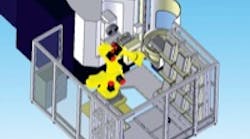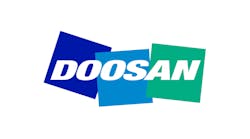Makino's automated cell for high-mix, low-volume work stores sub-pallets vertically.
The LM-8D system offers affordable automation for high-mix, low-volume production.
Shops in high-mix, low-volume production environments no longer can expect to compete simply by running lines of stand alone machining centers with an operator at each one. Labor costs are too high, and, more importantly, operating in such a fashion typically translates to only a 40-percent machineutilization rate because so much time is wasted loading and unloading workpieces and cleaning off workholding fixtures between parts. However, shops can boost machine-utilization rates to 50 percent, 80 percent, or as high as 95 percent by incorporating automation and horizontal machining centers.
The simplest forms of automation are automatic tool changing and automatic pallet changing. Combined, these two functions can increase a horizontal machining center's utilization 50 percent to 80 percent, given the right application. But, to catapult machine utilization into the 90-percent and above range, shops must take the next step in automation — multiple-pallet systems.
While usually associated with high-volume premium shops, multiple-pallet, pallet-pool, or pallet-magazine systems let shops that produce a high mix of low-volume jobs run machines unmanned and in lights out operations. For example, an 8-pallet system could accommodate eight or more different jobs or as many different operations on the same part. Essentially, these systems ramp up machine utilization without requiring a shop to increase its labor resources.
Along with multiple-pallets, many machine tool builders recommend that shops also use modular fixturing and some type of pallet-management system within a cell controller. Modular fixturing allows shops to quickly build workholding for virtually any workpiece from a kit of components in about four hours. The alternative is to make customdesigned fixtures that would take a lot more time and labor.
After running a job that uses modular fixturing, shops can take a digital photo of the fixture, or use the software that typically is included with modular-fixturing systems to document the specific fixtures it used. That lets the shop easily re-configure the fixtures for repeat orders and eliminates having to keep shelves full of fixtures for repeat orders.
A cell controller connects one or more machining centers to a pallet-changing system and keeps track of the parts that are loaded on the array of pallets. All part programs and any type of fixture-management software typically reside in the cell controller to provide "one-point" operation. Some cell controllers even accept videos or photographs of various part setups for future referencing.
As a pallet loads, the cell controller automatically delivers the appropriate part program to the machine it is destined for. By handling the whole cell on its own, the cell controller increases a shop's output without having to add more operators.
Robots Need Apply
While robots mostly apply to high-volume production, many of today's machine tool and manufacturing equipment suppliers offer robot systems that are designed specifically for automating high-mix, low-volume operations. Such systems are available from Makino (www.makino.com) and from Automated Concepts Inc. (www.automatedconcepts.com).
Makino's system consists of a robot that feeds subpallets of work into a horizontal machining center — typically a five-axis type machine. Locators that match up to the machining center's pallet ensure that each loaded sub-pallet is qualified to the machine tool, so the machine knows the sub-pallet's location.
Because sub-pallets are qualified to the machine tool, shops also can qualify the workpieces on those pallets to the machine tool. This eliminates the extra step of having to determine the workpiece location on the machine or qualifying the workpieces to the machine.
"When using conventional pallet-changing systems, shops still must qualify new fixtures to machine tools and make sure the parts on those fixtures are properly positioned," said Tim Jones, product line manager for horizontal machining centers at Makino.
Unlike conventional pallet systems that stack pallets horizontally, Makino's system stores its sub-pallets vertically. This allows the system to fit into a small space and eliminates the need for long lines of pallet-storage units. Only the work-setting stations in Makino's system are horizontal, so operators do not have to fight gravity when loading parts. According to Jones, sub-pallets and the fact they are stored vertically have been instrumental in Makino being able to apply robots to high-mix, low-volume work.
Automated Concepts takes a different approach to automation for high-mix, low-volume work. Its system, called the LM-8D, is a self-contained, off-the-shelf automation package that matches up to a shop's existing machine tool.
The system includes a Fanuc M 16i six-axis robot, a bidirectional five-drawer part feeder and a Fanuc "B" style controller. By using standard pre-engineered components such as these, Automated Concepts can offer the LM-8D for less than $100,000, a price that is about 25 percent to 40 percent less than a custom-designed system, Brian Turner, special services manager at Automated Concepts, said.
"A lot of shops tell us they need to automate, but they are often dissuaded by cost and a belief that the system won't be flexible enough. The LM-8D addresses these two constraints," he said.
Shops load various jobs into the system's feeder drawers. The feeder drawers adjust in height from 5 in. to 8 in. and accommodate workpiece diameters ranging from 2.5 in. to 4.5 in. The robot then opens an individual drawer shelf, removes a raw part and loads it into a waiting machine tool. Once the part is complete, the robot unloads it from the machine, places it back into the drawer from which it was taken or onto an outbound conveyor or into a bin, and loads another workpiece.
The robot handles various part shapes using a three-finger gripper system that includes six other aluminum finger blanks that can be used for different families of parts. Automated Concepts integrates its robots to machine tools via the machine tool's interface, so machine tools that are to be automated must be robot-ready. That means the machine tool must have the ability to interface a robot into its controller.
In addition to its other benefits, the LM-8D is portable because its robot and drawer unit are bolted to the same base/platform that is enclosed by steel wire safety fencing. After a run of jobs on one type of machine, a shop can simply fork truck the whole system to a different machine. The LM8D applies to any type of machining operation — milling, turning, grinding and others, and plans are in the works for an LM-8D system that will feed two machines. The current model is designed to tend only one machine at a time.
Also, because the robot and drawer feeder rest on the same platform, the robot always knows the feeder's position. Shops do not have to re-teach the robot where the feeder is after moving the system to a different location. Once the system is positioned, it is simply a matter of touching the robot to the machine's workholding to teach it where the machine is, running air and power to the system and connecting it to the machine's I/O block.



